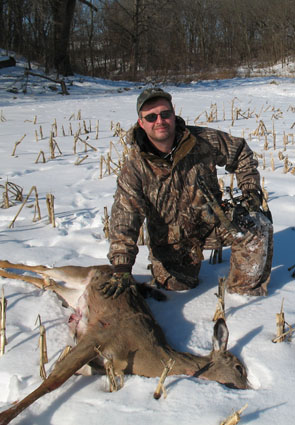 It was December 2006. With only three days of Christmas vacation left, an expensive non-resident deer tag in my pocket and a gaping canyon in my freezer, I was starting to feel the pressure. The following few evenings would offer my last shot at the elusive whitetail until the next September, better than eight months away. I did not like the prospects of spending those months pondering missions unaccomplished, and especially the cruel reminder of buying meat at the market — an act I truly despise.
It was December 2006. With only three days of Christmas vacation left, an expensive non-resident deer tag in my pocket and a gaping canyon in my freezer, I was starting to feel the pressure. The following few evenings would offer my last shot at the elusive whitetail until the next September, better than eight months away. I did not like the prospects of spending those months pondering missions unaccomplished, and especially the cruel reminder of buying meat at the market — an act I truly despise.
Piling on the pressure was the fact that I knew in my heart I just wasn’t onto the deer. I’d found good sign in the snowy Wisconsin river bottom and gotten on some excellent trails, but the movement was too spread out and sporadic for me to pattern anything. I could move my hunting spot, but that would take time and be risky. I was on the horns of a dilemma, as they say.
That day I made a decision, and evening found me not in stand, but on the lookout. From the high Blue Hills bluff I overlooked a patchwork of landscape in shades of snowy white, clouds of crystallized vapor obscuring the genius of Carl Zeiss as I picked apart the scene. Then there it was: From a thick beaver swamp, a small group of does ventured tentatively along a fence line. As they moved cautiously, stopping often, I scanned ahead and found their objective: A stack of hay in an isolated pasture. Then I knew I was onto something but wanted to know more, and as the snowy landscape began to purple in the failing light, saw what I was really looking for. The buck was last in line, his antlers so bleached they were barely visible against the winter ground. But I knew they were big.
The next afternoon saw me latching down a stand and climbing in for a long wait, fingers already numb. In the thin line of cover I was exposed to a bitter breeze, but I didn’t mind because it was blowing the right direction. As daylight began to fade, I saw a brown spot move against white in the distance through bare trees. I reached for my bow.
I’d like to report that I brought down the ivory-horned buck, but I can’t. I can say I secured my winter’s venison that evening, and that, for me, is a very meaningful accomplishment no matter how many the years it’s been done.
The Key
Winter whitetails by bow are tough no matter what. The cruel conditions multiply against you; it’s amazing how many ways there are to fail at late-season bowhunting.
But there is a key, a strong and universal advantage — food. Harvest and dormancy decimate the available food for whitetails, and the deeper the snow, the more scarce the food becomes. Find food and you’ll find deer. Big bucks especially are keyed to food to rebuild body mass lost during November’s chase.
There are a variety of ways to use winter food to bowhunt deer. Here are a few of my favorites.
Crops And Plots
Planted forage or the remains thereof is the key to late-season bowhunting in most areas. Whether it’s a rare unharvested field of corn or soybeans, wasted grain or hay stubble, a plot of beets or rape planted especially for winter hunting, or — in the case of my story, — a haystack, agriculture is what most bowhunters will depend on now.
The essential ingredients are finding a reliable pattern of deer access trails you can cover in bow range, making sure the deer are accessing the food in shooting hours, and setting up and hunting undetected.
It can take a lot of scouting to find a high-odds situation. Once you locate one, you must analyze it to see if it’s huntable considering the prevailing winds and direction of deer travel. Set your stand in good cover if it’s available, or you’ll probably have to go high. Remember, these deer have been hunted for four months and are probably looking up in the trees for danger.
In some agricultural spots it’s often best to find a staging area, where deer hang out in the evening before earnestly moving to food. If you’re hunting food plots that have had concentrated hunting through the season, you’ll do best to get off the field edge and well back onto the access trail.






